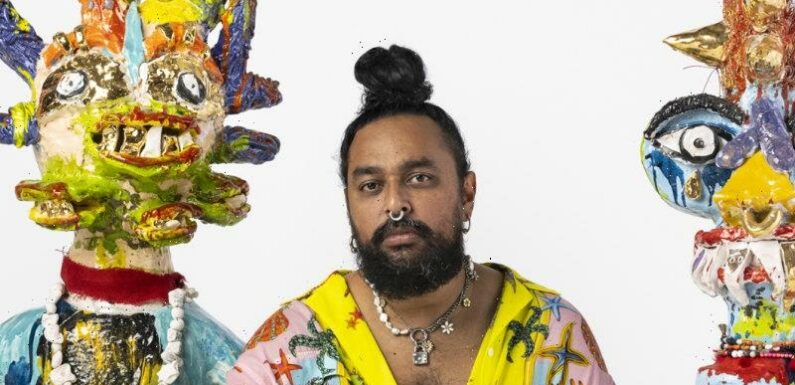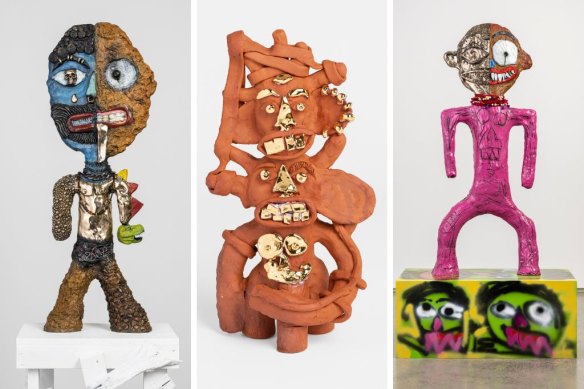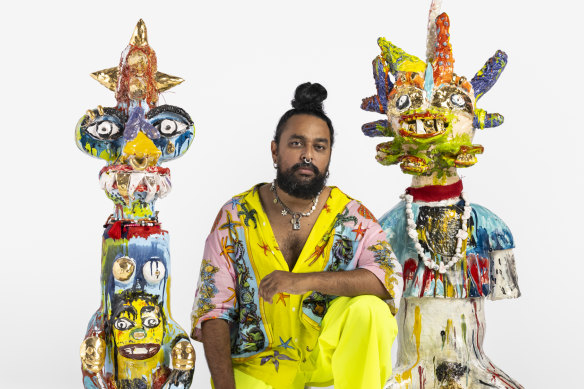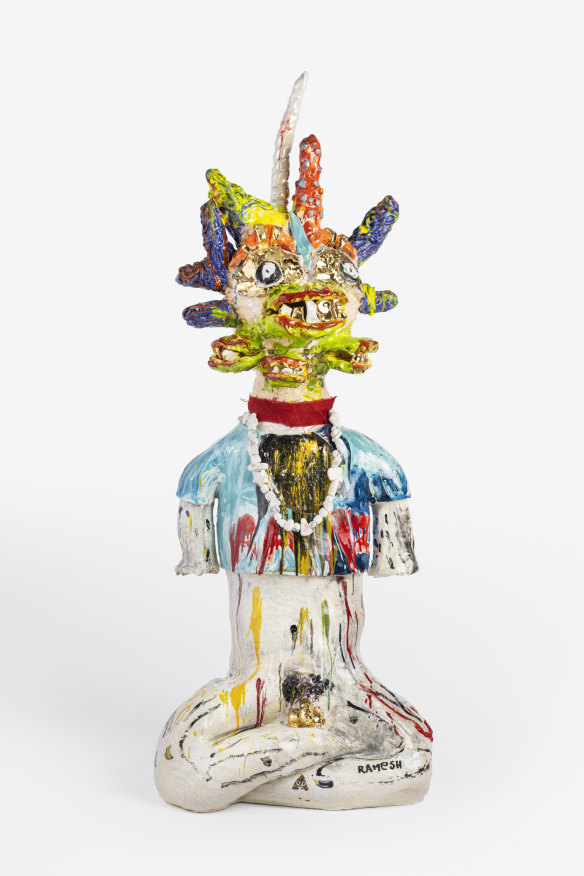
By Kylie Northover
Works by Ramesh Mario Nithiyendran, from left, Bi Muddy Figure, Terracotta figure with Multiple Heads, and Bi Warrior Figure. Credit:Courtesy the artist and Sullivan + Strumpf
Pottery is not something one usually associates with deviance, but Sydney artist Ramesh Mario Nithiyendran was, for a time, referred to as the “bad boy of ceramics”. That’ll be the phalluses.
The Sri Lanka-born artist’s vibrantly coloured ceramic figures, which reference Hindu gods and deities, have often featured phalluses and other organs.
“It’s kind of funny. I think when ceramics became popular as an artform in Australia, people weren’t really used to seeing sculpture with a capital S,” says Nithiyendran. “When I started making them they were expressive – because I trained in painting and I was always interested in painterly gestures – and also the imagery was, in inverted commas, “edgy”, so I think a lot of people … projected things onto me.”
Not that he’s moved on to doing innocuous homewares, though. “No, I don’t want to do vases!”
Sydney-based Nithiyendran, who is also an associate lecturer at the UNSW School of Art and Design, was trained in painting and drawing, but is self-taught in the medium for which he’s become known, creating brightly coloured “idols” that explore ideas of religion, monuments, and sex and gender.
Ramesh Mario Nithiyendram with works from his new show <i>Undergod</i>.Credit:Mark Pokorny
Nithiyendran’s family migrated to Australia from Sri Lanka when he was a baby, and his parents came from different backgrounds; his mother had a Christian upbringing while his Tamil father was raised Hindu. Nithiyendran says he was never very religious but growing up with both faiths influenced his work, which attempt to “make sense of idolatry amid an era of rising global nationalism”.
This month his largest solo show to date has opened in Melbourne, his first here since 2016. Undergod features more than 20 new figurative sculptures across various media, including bronze, ceramics and lighting, including six large-scale bronze works, two of which are kinetic. It’s a huge show but Nithiyendran is not one for minimalism. “If I’m going to do a solo show, it needs impact.”
One of the works in Ramesh Mario Nithiyendran’s exhibition, Undergod.Credit:Mark Pokorny
“I’ve worked with bronze since 2016, but this is actually the first time I’m presenting bronzes as a key part of the body of work,” he says. The kinetic works were initially commissioned by software company Atlassian in partnership with ACCA, but this is the first time they’ll be shown to the public.
Working with his deliberately haphazard aesthetic, Nithiyendran has used turning mechanisms on his sculptures heads; the works will “respond” to someone coming within a metre of them. Using randomised rotations, the works, which Nithiyendran says are “like warriors, almost guardian figures”, are double-sided, so when you approach them, the heads turn to reveal a face on the other side.
“You end up with four variations of the sculpture through the turning mechanism – and the turning mechanism isn’t complex; you can hear the motors turning. I like to reveal what’s going on from a technical perspective. I think that’s interesting for an audience as well.”
The idea, too, he says, was to merge different historical frameworks of figurative sculpture, “having things that might appear ancient, but bringing in technology that’s very much of today, to mix those material languages”.
While much of Nithiyendran’s work has blended Hindu mythology with Christian archetypes, he’s recently become interested in the idea of Syncretism, the concept of blending different religions. “And the way in which figurative sculpture, schools of thoughts and religions have actually changed through cross-cultural contact,” he says.
“One of the images I was looking at for this exhibition was Gandhara Buddha, a type of buddha that originated in the ancient region of Gandhara, which is now north-west Pakistan. What’s interesting about those figures is they have Greco-Roman elements to them because Alexander the Great moved through that area.
“I’m interested in what we regard as very regionally specific narratives; when you look at them, they’re actually about multiple regions.”
Undergod also explores iconoclasm and the way idols and religious iconography have been changed or edited though monuments, idols and artworks historically being stolen or traded. “A lot of the show emerged from looking at the headless torsos, limbless Buddhas, in a lot of state and national collections globally, and reflecting on the provenances of them,” Nithiyendran says.
Many of his works have been roughly “assembled” to reflect this fragmentation. “It’s looking at this idea of rebuilding, or thinking about what idolatry in the future represents, or [might] be. Even though I’m looking at the past, I think it’s such a pertinent issue socially and politically currently, especially when we’re thinking about repatriation.”
Undergod will also feature LED lighting; he’s used lighting as a medium before at Dark Mofo and for a show at Carriageworks in Sydney.
“It’s a crazy lighting treatment – it’ll be wrapped around the plinths, and there’ll be flashing lights. I’m really activating the work through that medium,” he says. “It’ll look dramatic, if anything.”
Just don’t expect too many phalluses. “There are some sneaky ones, but I think the imagery has become a lot more … metaphorical rather than literal,” Nithiyendran says. “A lot of the gendered imagery in this show is quite multi-gendered, so things with pronounced phalluses also have breast-like forms, but I think the references and the imagery are a bit … different now.”
More subtle? “Well, I think the imagery might be, but I wouldn’t say my work is subtle!”
Undergod is at Sullivan+Strumpf, Collingwood, until April 22. sullivanstrumpf.com
Most Viewed in Culture
Source: Read Full Article


